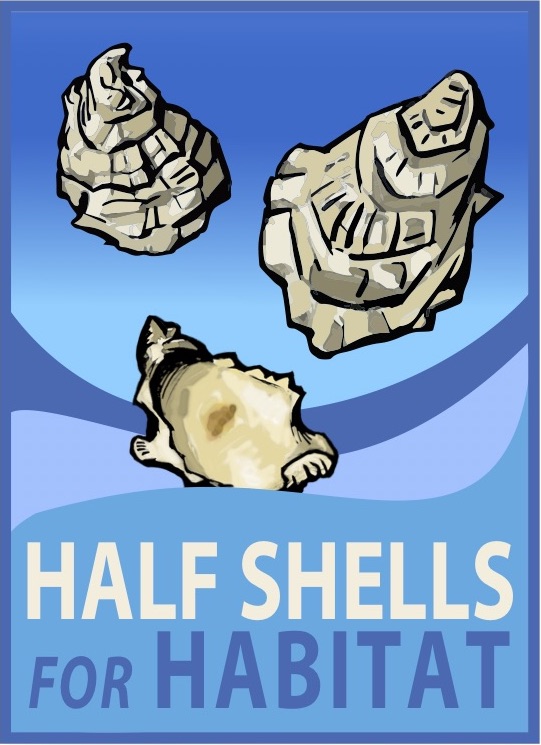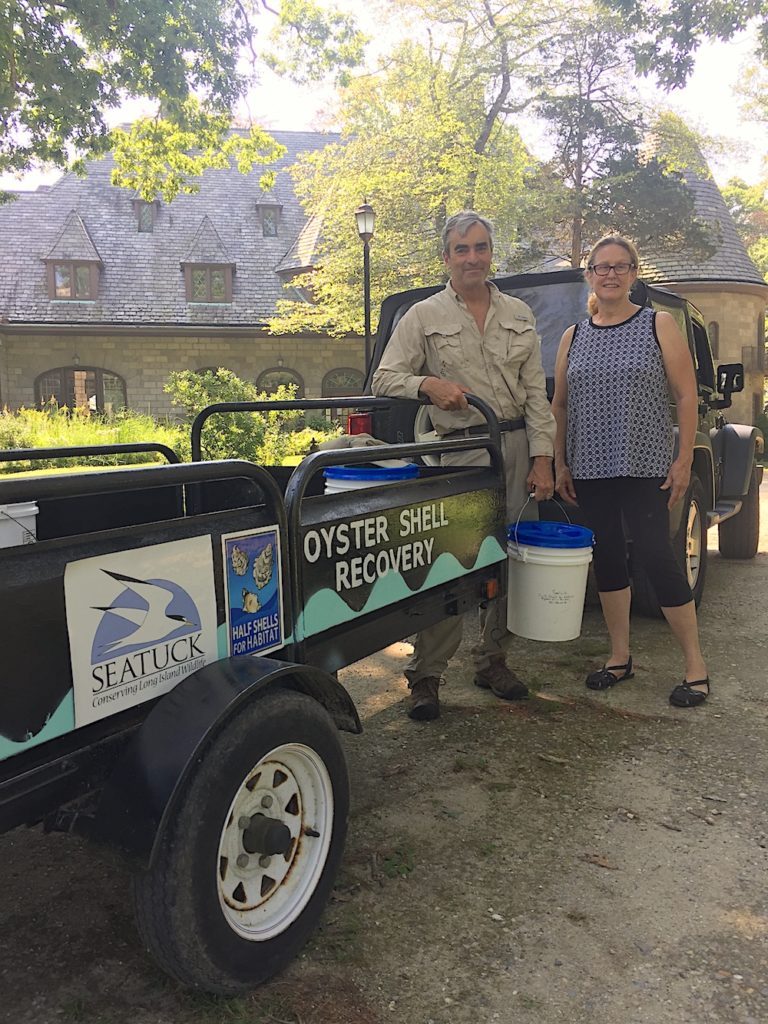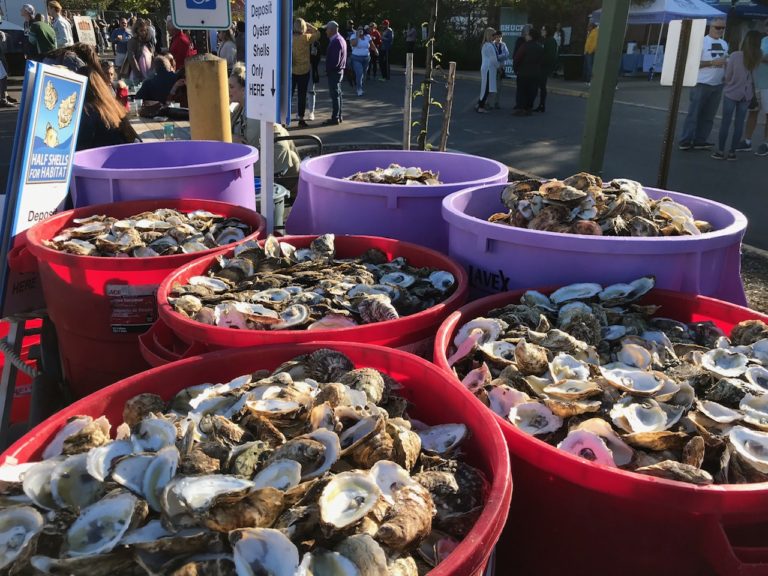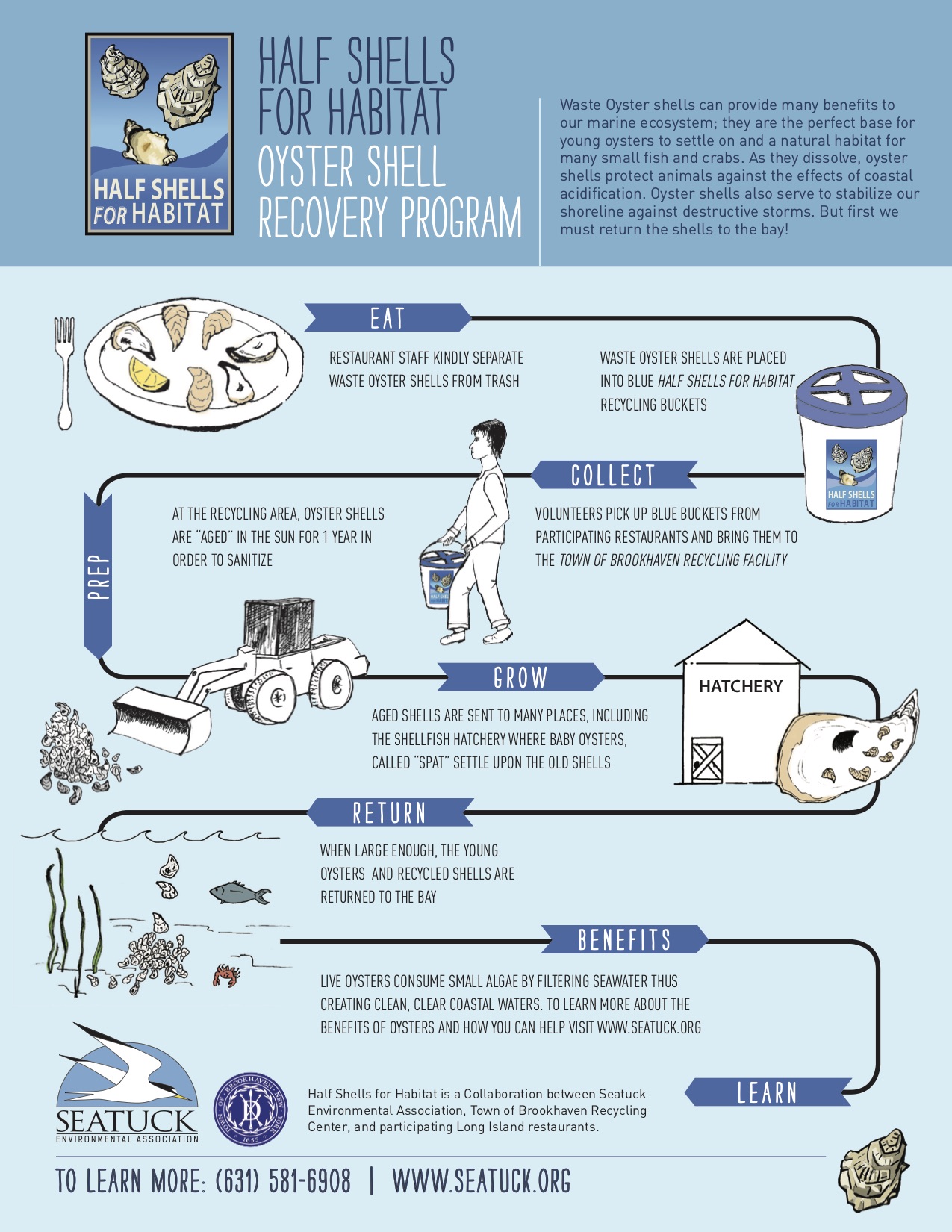Half Shells for Habitat

Half Shells for Habitat
Oyster Recovery Program
Half Shells for Habitat (H4H), which was initiated by Seatuck and a host of partners in 2018, is an island-wide program to recover oyster shells from restaurants for use in oyster and habitat restoration efforts.
Maureen Dunn, Seatuck’s Water Quality Scientist (pictured below at right with Seatuck board member Charlie Weiss), conceived and established the program to address the critical need to return oyster shells to Long Island’s estuaries. The shells provide vitally important substrate on which young oysters can attach and grow, and they help to combat coastal acidification by returning calcium carbonate to the water (see diagram below for more detail).
About the Program
Seatuck initially partnered with the Town of Brookhaven to launch the program. With Town Supervisor Edward Romaine’s enthusiastic support, a shell storage site was established at their composting facility in Manorville (pursuant to NYSDEC regulations, after being collected, the shells have to sit in the sun for at least 6 months before going back in the water).
The project was piloted with the generous cooperation of Catch Oyster Bar in Patchogue and three of the Bohlsen Restaurant Group’s restaurants: Teller’s (Islip), H2O (east Islip), and Prime (Huntington). The Snapper Inn (Oakdale) and The Cull House (Sayville) also joined the program as early participants.
H4H has continued to grow since the pilot project with the Town of Islip also coming on board as a partner and establishing a shell storage site at their recycling and compost facility. The full list of participating restaurants has expanded to include the following:
Participating Restaurants:
Half Shells for Habitat reached an important milestone in late May 2019 when fully-aged shells were picked up at the Town of Brookhaven’s storage site. Since then, Cornell Cooperative Extension’s Long Island Shellfish Restoration Project, Stony Brook university’s Shinnecock Bay Restoration Program, and Moriches Bay Project have returned shells back to our bays for use in their oyster restoration and reef-building projects. in total, the Half Shells for Habitat program has collected over 70,000 lbs of waste oyster shells. Out of the 70,000 lbs, there have been 11,420 lbs that have returned to the South Shore Bays.
The growth of the program depends on its ability to engage additional participating restaurants, attract shell transport volunteers, and make deliveries of shells to the storage sites. Interested people are urged to contact Arielle Santos, Volunteer Coordinator, at [email protected] or (631) 581-6908.

1. Enhanced Water Quality and Clarity – Oysters consume microscopic algae called phytoplankton, which helps to clarify seawater and promote eelgrass growth. In addition, the removal of harmful phytoplankton decreases the likelihood of harmful algal blooms, such as Brown and Rust Tides.
2. Habitat for Wild Oyster Restoration – In many bays, wild oysters can’t take hold because of the lack of the hard substrate they require for attachment. This substrate, which was historically provided by other oyster shells, is restored when recovered shells are returned to the water. They provide the necessary substrate for “wild set” oysters, which are important for natural disease resistance and genetic diversity in overall oyster populations.
3. Regulating Nitrogen Pollution – Oysters grow well in nitrogen-rich waters. They remove nitrogen from seawater by consuming phytoplankton that have the ability to incorporate nitrate. At harvest time, farmed oysters and the nitrogen they’ve consumed are removed from the environment. The consumption of wild oysters by transient wildlife also serves to rid the local environment of excess nitrogen.
4. Reduce Landfill/Incineration – Recycling oyster shells reduces the cost of delivering and disposing of them as waste in landfills or burning them in incinerators.
5. Shoreline Stabilization – Oyster shells can be used to stabilize eroding shorelines in salt marshes, or as part of a reef building process with the reintroduction of live oysters. Oyster reefs mitigate the damaging wave effects of severe storms and hurricanes. As sea level rises at an ever-accelerating rate, these efforts will help protect our shorelines.
6. Mitigate Coastal Acidification – Excessive algae growth in Long Island’s coastal waters fuels high levels of the bacteria that decompose the algae. The bacteria use oxygen and produce CO2 as they respire. This increased CO2 lowers the pH of the water (already low from atmospheric absorption of CO2 in ocean waters), causing what is known as “coastal acidification.” This condition, which is increasing around Long Island, presents a significant threat to our estuaries and wildlife (including young oysters, which are especially sensitive to pH changes). The calcium carbonate of recycled oyster shells provides a buffer against coastal acidification, acting like an antacid as they dissolve.
7. Provide Mesohabitat – Wild oyster reefs provide important habitat for small fish, shrimp and juvenile crustaceans. While aquaculture structures can mimic this habitat, it is removed at harvest time and lost. Wild oyster reefs are necessary to provide permanent, long-term mesohabitat for marine wildlife.
8. Carbon Sink – Shells are made of calcium carbonate; when burned as kitchen waste they emit carbon into the atmosphere. However, when bound together in an oyster reef, the same shells instead serve as a carbon sink.
9. Community Involvement and Education – Shell recovery and restoration relies on volunteers to collect shells from participating restaurants, assist with spat-on-shell rearing and a wide range of other jobs. In the process, it educates volunteers and empowers them as ambassadors to engage the general public in the work to protect and restore our coastal ecosystem.
10. Quality of Life & Tourism – Oysters not only enhance the health of our coastal waters, but they are also a prized culinary delicacy for which Long Island is renown. These important roles are both critical in supporting the quality of life and tourism that is so vital to Long Island’s economic health.

Shellapaloosa 2021!
Half Shells for Habitat was proud to announce the first-ever “Shellapaloosa“! The weekend-long oyster celebration kicked off on August 5th, 2021 with a free Zoom webinar titled, “Restaurants to Restoration: The Story of a Recycled Oyster Shell”. Panelists included experts from the field.
Not only did participants have the opportunity to learn the who, what, where, and why we recycle oyster shells on Long Island, webinar attendees also received a 15% off “oyster voucher” redeemable at any one of the Shellapaloosa participating restaurants on an order of oysters!
The Zoom webinar recording can be found below. Please reach out to Arielle Santos, Half Shells for Habitat Volunteer Coordinator, with any questions at [email protected].

